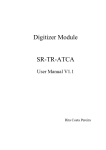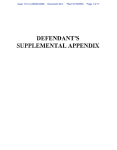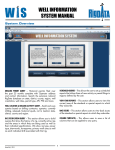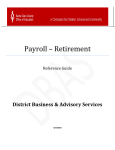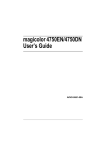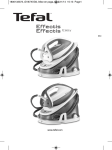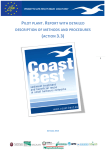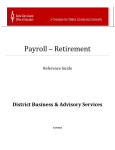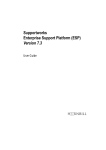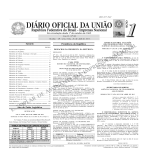Download New England RIG User`s Manual
Transcript
REMOTE INTELLIGENT GATEWAY USER MANUAL for ISO New England Electronic Dispatch Project Revision 1.0 September 2006 Qualitrol Company LLC 1385 Fairport Road Fairport, NY 14450 Revision History Revision Version 0.4 Date Comments January 2002 Initial Release Modifications: Version 1.0 September 2006 • Added Advantech CPU and chassis descriptions • Updated RIG graphic displays • Updated Modbus register definitions to include ASM reserve prices and to add the fractional component of select MW values • Updated FTP file format to cover the ASM reserve prices and to reflect the fractional component of select MW values Table of Contents 1.0 SYSTEM OVERVIEW....................................................................................................................... 1 1.1 Alarm Annunciator ..............................................................................................................................................2 1.2 Serial / Ethernet Interface ..................................................................................................................................2 2.0 RIG G RAPHIC DISPLAYS ...............................................................................................................3 2.1 Asset Summary Display.......................................................................................................................................4 2.1.1 General RIG Information .........................................................................................................................5 2.1.2 Real Time Prices..........................................................................................................................................6 2.1.3 Asset Summary ............................................................................................................................................6 2.1.4 Asset Summary Message Entry.................................................................................................................8 2.1.4.1 Message Selection............................................................................................................................. 8 2.1.4.2 Message Acknowledgement............................................................................................................ 8 2.2 Asset Detail/History Display .............................................................................................................................9 2.2.1 General RIG Information .......................................................................................................................10 2.2.2 Pricing Information ..................................................................................................................................11 2.2.3 Asset Detail/History Information .........................................................................................................12 2.3 RIG Health and Status Display ........................................................................................................................14 2.3.1 General RIG Information .......................................................................................................................15 2.3.2 RIG Health and Status Information Section ........................................................................................16 3.0 RIG HARDWARE DESCRIPTION .................................................................................................. 19 3.1 Motorola Unit .....................................................................................................................................................20 3.1.1 Internal Components / Connections ....................................................................................................21 3.1.1.1 Chassis Connections ...................................................................................................................... 21 3.1.1.2 Solid State Hard Drive................................................................................................................... 21 3.1.2 External Connections ...............................................................................................................................22 3.1.3 PV5000-200 CPU......................................................................................................................................23 3.2 Advantech Unit...................................................................................................................................................24 3.2.1 Internal Components ...............................................................................................................................25 3.2.2 CPU Connections .....................................................................................................................................26 3.2.2.1 Chassis Connections ...................................................................................................................... 26 3.2.3 External Connections ...............................................................................................................................27 3.2.4 Advantech CPU ........................................................................................................................................28 3.2.4.1 Compact Flash Drive..................................................................................................................... 29 4.0 RIG ALARM SYSTEM ................................................................................................................... 30 4.1 Relay Output Module ........................................................................................................................................30 4.1.1 Module Installation ...................................................................................................................................30 4.1.2 Electrical Connection...............................................................................................................................30 4.2 Alarm System Operation...................................................................................................................................31 4.2.1 System Status Mode..................................................................................................................................31 4.2.2 Unit Status Mode ......................................................................................................................................32 5.0 MODBUS SLAVE INTERFACE ....................................................................................................... 33 5.1 Modbus Interface Connection .........................................................................................................................33 5.1.1 Electrical Connection...............................................................................................................................33 5.2 Dispatch Data Access........................................................................................................................................34 5.3 Dispatch Data Layout........................................................................................................................................35 5.4 DDP Alert Message Acknowledgment...........................................................................................................38 6.0 FTP INTERFACE ........................................................................................................................ 39 6.1 FTP Interface Configuration............................................................................................................................40 i Table of Contents 6.1.1 Second Ethernet Module.........................................................................................................................40 6.1.1.1 Electrical Connection .................................................................................................................... 40 6.2 Dispatch Data Access........................................................................................................................................41 6.3 FTP Data Files....................................................................................................................................................41 6.3.1 CURDDP.TXT File Fields......................................................................................................................41 6.3.2 CURDDP.TXT File Structure................................................................................................................44 6.3.3 HDDPMMDD.TXT File Structure.......................................................................................................44 6.3.4 ACK.TXT File Structure .........................................................................................................................45 6.3.5 CFG.TXT File Structure..........................................................................................................................46 7.0 APPENDIX A - ALARM INTERFACE MODE SELECTION ................................................................ 47 8.0 APPENDIX B - GENERATOR FILE TRANSFER FORM .................................................................... 48 ii RIG User Manual 1.0 SYSTEM OVERVIEW The ISO New England (ISO-NE) system interfaces with multiple generator sites that supply power to the New England area and with large commercial loads called Dispatchable Asset-Related Demand (DARD) within the same area. The Danaher DAS4000 system dispatches power data information from the ISO-NE to the participating Generators and DARDs in remote locations. The dispatch message calls for the startup or shutdown of specific generators and/or provides a generation/consumption setpoint based on the current system demands and other variables as defined in the Oracle Database. ISO New England Router Oracle Database DAS4000 Workstation Dispatch Message Frame Relay Network Router Alarm Annunciator RIG Monitor Serial Ports Keyboard Ethernet Link to Local LAN Power Plant & Dispatchable Commercial Load The dispatch message is sent to the RIG (Remote Intelligent Gateway) on a secure network through Cisco routers utilizing the Verizon-Frame Relay network protocol. Network security is maintained by utilizing digital certificates and preserved by requiring certificates to be renewed each year. The RIG processes the dispatch message at the remote power plant or commercial load. The dispatch information is available in graphic displays at the RIG monitor and saved to internal files. The file data can be accessed by other computer systems on the local network for reporting purposes or additional processing. 1 RIG User Manual 1.1 ALARM ANNUNCIATOR The Alarm Annunciator consists of a relay output module that can be connected to external audio or visual devices. This feature is used to notify RIG operators when a dispatch message has been received. The Annunciator can be configured to annunciate on an asset or system basis to meet the specific needs of the plant operation. 1.2 SERIAL / ETHERNET INTERFACE During operation, dispatch data, historical data and system statistical data is maintained in the RIG. This information is available to computer systems on the plant network for data analysis or reporting purposes. The RIG supports the Modbus protocol on an RS232 serial port or TCP/IP on an optional Ethernet port. 2 RIG User Manual 2.0 RIG GRAPHIC DISPLAYS The RIG graphic displays are accessed by pressing a keyboard function key. The displays include: • Asset Summary Display • Asset Detail / History Display • RIG Health & Status Display The graphic displays can also be opened by clicking on a soft key element located at the bottom of each RIG display. • F1 – SUMMARY opens the Asset Summary Display • F2 – ASSET DETAIL/HISTORY opens the Asset Detail / History Display • F3 – RIG STATUS opens the RIG Health & Status Display When a graphic is not available, the associated soft key will not be active as shown below. Only the F1SUMMARY and F3-RIG STATUS displays can be selected from the screen. NOTE The F12-ACK soft key is used to acknowledge specific dispatch message types. 3 RIG User Manual 2.1 ASSET SUMMARY DISPLAY The Asset Summary Display is the main RIG display. It can be accessed by pressing the keyboard <F1> key or clicking on the F1 – SUMMARY soft key at the bottom of the display. The information available to the RIG user is presented in three sections. 4 RIG User Manual 2.1.1 General RIG Information The following information appears in this section: • Version ASM Phase II – 10/01/2006: Release version and date of the software installed on the RIG • Designated Entity RIG001: Unique identifier of the designated entity responsible for the assets associated with the RIG. • RIG001: The RIG name • Today: The current date on the RIG • New DDP Received: The time the last DDP was received • Mode: Current mode of messages received for the assets associated with the RIG • NORMAL Messages for all assets associated with the RIG are of type NORMAL EMERGENCY One or more of the messages for any asset associated with the RIG are of type EMERGENCY, STARTUP, or SHUTDOWN. This string will be highlighted. Comm Status: Indicates the current communications status with the Dispatch Data Server OFF-LINE RIG has lost communications with the data server. This string will be highlighted ON-LINE RIG is communicating with the data server NOTE When the RIG is connected to the data server, an indication of the ON-LINE status will be presented as a heartbeat below the Comm Status field each second. First, one asterisk (*) will appear, then two(**), then three (***). The sequence will repeat as long as the RIG is connected to the data server. 5 RIG User Manual 2.1.2 Real Time Prices The following information appears in this section: • Time: The current time on the RIG • Current 5-Minute Regulation Price: The price $/MWh currently paid for regulation to generators on AGC control – generators in UCM 6 2.1.3 Asset Summary The Asset Summary section is a tabular listing of the most recent message for each asset associated with the RIG. The messages are listed alphabetically by the Asset ID. A message entry in the Asset Summary display includes the following information: • Asset ID: Unique asset identifier • Msg Type: Displays the most recently received message type: • 6 N Normal E Emergency U Startup D Shutdown UCM: Unit Control Mode 1 Off-line Unavailable 2 Off-line Available RIG User Manual 3 Fixed 4 Dispatchable 5 Postured (Generators only) 6 On Regulation (Generators only) • Act Gen/Con: Actual MW of generation for a generator or consumption for an asset-related demand, displayed with one digit after the decimal point. • DDP: The requested dispatch MW data point, displayed with one digit after the decimal point. • Dev: Deviation between actual generation/consumption and the DDP value, displayed with one digit after the decimal point. • Last Updt: The time that the most recent message was generated. Format = hhmm • Eco Max / Max Cons: Economic Maximum dispatch limit for a generator; Maximum Consumption dispatch limit for an asset-related demand • Reg High: Maximum Regulation MW limit – The maximum MW value to which a Participant is willing to operate a generator when the generator is under automatic generation control by the ISO. Not applicable to asset-related demands. • Reg Low: Minimum Regulation MW limit – The Minimum MW value to which a Participant is willing to operate a generator when the generator is under automatic generation control by the ISO. Not applicable to asset-related demands. • Eco Min / Min Cons: Economic Minimum dispatch limit for a generator; Minimum Consumption dispatch limit for an asset-related demand • Emer Min: Emergency Minimum dispatch limit for a generator. Not applicable to asset-related demands. • Self Sched: The self schedule status of the asset. There are four possibilities: blank Not self-scheduled E Self-scheduled for Energy R Self-scheduled for Regulation. Not applicable to asset-related demands. B Self-scheduled for both Energy and Regulation. Not applicable to assetrelated demands. • Resp Rate: Response Rate of the asset as offered/bid by the Participant or as re-declared. It is the response rate corresponding to the asset’s actual generation/consumption if the Participant submitted offers/bids with multiple response rates and the response rate has not been redeclared. For generators in AGC control mode (UCM 6), the response rate shown is the Automatic Response Rate in effect. • Reg Range: Regulating Range – Applicable only to generators under automatic generation control by the ISO, i.e., generators in AGC control mode (UCM 6). • Nodal Dsp Rt $/MWh: Ex-ante nodal dispatch rate at the node where the asset is located, as calculated by the pricing and dispatch software. • FTF: Failure-to-Follow flag – F is displayed if the asset is not following its DDP • Pos: Postured Flag – P is displayed if the asset is postured and being sent a manual DDP 7 RIG User Manual 2.1.4 Asset Summary Message Entry The message entries in the Asset Summary display are color coded according to message type. The message entry color indicates the following: • Green – Normal message type that has not changed since the last DDP • Yellow – Normal message type that has changed since the last DDP • Flashing Red – An Emergency, Startup, or Shutdown message type that requires operator acknowledgement. • Red – An Emergency, Startup, or Shutdown message type that has been acknowledged. 2.1.4.1 Message Selection To select a message in the Asset Summary display, use the up/down arrow keys or click on the message line with the mouse pointer. The selected message is highlighted. 2.1.4.2 Message Acknowledgement When an Emergency (E), Startup (U) or Shutdown (D) dispatch message is sent to the RIG, the message entry in the Asset Summary display flashes and audio and visual alarms (if installed) are activated. The RIG operator must acknowledge receipt of the message by selecting the message, then pressing the keyboard <F12> key or clicking on the F12-ACK softkey at the bottom of the display. When the acknowledgement is processed, the message entry stops flashing and alarms are deactivated. If an Emergency (E), Startup (U) or Shutdown (D) dispatch message is sent for more than one asset associated with the RIG, the operator must acknowledge each asset individually. The operator then initiates the appropriate action based upon plant procedures. NOTE The dispatch message can also be automatically acknowledged by using an optional Modbus or FTP Interface. 8 RIG User Manual 2.2 ASSET DETAIL/HISTORY DISPLAY To open the Asset Detail/History Display, select a message entry in the Asset Summary Display for the desired asset. Press the keyboard <F2> key or click on the F2 - ASSET DETAIL/HISTORY soft key at the bottom of the display. The selected asset is identified in the center of the display after Asset ID and the current time appears after Time. The information available to the RIG user is presented in three major sections. 9 RIG User Manual 2.2.1 General RIG Information The following information appears in this section: • Version ASM Phase II – 10/01/2006: Release version and date of the software installed on the RIG • Designated Entity RIG001: Unique identifier of the designated entity responsible for the assets associated with the RIG. • RIG001: The RIG name • Today: The current date on the RIG • New DDP Received: The time the last DDP was received • Mode: Current mode of messages received for the assets associated with the RIG • NORMAL Messages for all assets associated with the RIG are of type NORMAL EMERGENCY One or more of the messages for any asset associated with the RIG are of type EMERGENCY, STARTUP, or SHUTDOWN. This string will be highlighted. Comm Status: Indicates the current communications status with the Dispatch Data Server OFF-LINE RIG has lost communications with the data server. This string will be highlighted ON-LINE RIG is communicating with the data server NOTE When the RIG is connected to the data server, an indication of the ON-LINE status will be presented as a heartbeat below the Comm Status field each second. First, one asterisk (*) will appear, then two(**), then three (***). The sequence will repeat as long as the RIG is connected to the data server. 10 RIG User Manual 2.2.2 Pricing Information Reserve market clearing prices are particular to each reserve zone. Since the assets associated with a RIG do not necessarily belong to the same reserve zone, the reserve prices for the zone, in which the selected asset is found, are shown in this section. TMSR Ten-Minute Spinning Reserve market clearing price. The price in $/MWh paid to generation capability within the reserve zone that is synchronized to the system and can respond within 10 minutes to provide contingency protection. TMNSR Ten-Minute Non-Spinning Reserve market clearing price. The price in $/MWh paid to generation capability within the reserve zone that is not synchronized to the system and can respond within 10 minutes to provide contingency protection. TMOR Thirty-Minute Operating Reserve market clearing price The price in $/MWh paid to generation capability within the reserve zone that can respond within 30 minutes to provide contingency protection over and above the 10-minute reserve capability. 11 RIG User Manual 2.2.3 Asset Detail/History Information The section contains a tabular listing of messages for the selected asset. The messages are listed in chronological order with the most recently received message listed at the top. The user can scroll through the messages by using the up and down arrow keys on the keyboard Each message entry is color coded: Green Normal message type (N) Red Emergency (E), Startup (U), or Shutdown (D) message type • • 12 Msg Type: Displays the most recently received message type: N Normal E Emergency U Startup D Shutdown UCM: Unit Control Mode 1 Off-line Unavailable 2 Off-line Available 3 Fixed 4 Dispatchable 5 Postured (Generators only) 6 On Regulation (Generators only) • Act Gen/Con: Actual MW of generation for a generator or consumption for an asset-related demand, displayed with one digit after the decimal point. • DDP: The requested dispatch MW data point, displayed with one digit after the decimal point. • Dev: Deviation between actual generation/consumption and the DDP value, displayed with one digit after the decimal point. RIG User Manual • Last Updt: The time that the most recent message was generated. Format = hhmm • Eco Max / Max Cons: Economic Maximum dispatch limit for a generator; Maximum Consumption dispatch limit for an asset-related demand • Reg High: Maximum Regulation MW limit – The maximum MW value to which a Participant is willing to operate a generator when the generator is under automatic generation control by the ISO. Not applicable to asset-related demands. • Reg Low: Minimum Regulation MW limit – The Minimum MW value to which a Participant is willing to operate a generator when the generator is under automatic generation control by the ISO. Not applicable to asset-related demands. • Eco Min / Min Cons: Economic Minimum dispatch limit for a generator; Minimum Consumption dispatch limit for an asset-related demand • Emer Min: Emergency Minimum dispatch limit for a generator. Not applicable to asset-related demands. • Self Sched: The self schedule status of the asset. There are four possibilities: blank Not self-scheduled E Self-scheduled for Energy R Self-scheduled for Regulation. Not applicable to asset-related demands. B Self-scheduled for both Energy and Regulation. Not applicable to asset-related demands. • Resp Rate: Response Rate of the asset as offered/bid by the Participant or as re-declared. It is the response rate corresponding to the asset’s actual generation/consumption if the Participant submitted offers/bids with multiple response rates and the response rate has not been redeclared. For generators in AGC control mode (UCM 6), the response rate shown is the Automatic Response Rate in effect. • Reg Range: Regulating Range – Applicable only to generators under automatic generation control by the ISO, i.e., generators in AGC control mode (UCM 6). • Nodal Dsp Rt $/MWh: Ex-ante nodal dispatch rate at the node where the asset is located, as calculated by the pricing and dispatch software. • Emer Ack: Emergency Acknowledge flag. If the message type is E (Emergency), U (Startup), or D (Shutdown), a 1 (one) appears in this column if the message was acknowledged and a 0 (zero) appears if the message was not acknowledged. If the message type is N (Normal), a 0 (zero) appears in this column. • FTF: Failure-to-Follow flag – F is displayed if the asset is not following its DDP • Pos: Postured Flag – P is displayed if the asset is postured and being sent a manual DDP 13 RIG User Manual 2.3 RIG HEALTH AND STATUS DISPLAY The RIG Health and Status Display is accessed by pressing the keyboard <F3> key or clicking on the F3 – RIG STATUS soft key at the bottom of the screen. A description of each section of the display follows… 14 RIG User Manual 2.3.1 General RIG Information The following information appears in this section: • Version ASM Phase II – 10/01/2006: Release version and date of the software installed on the RIG • Designated Entity RIG001: Unique identifier of the designated entity responsible for the assets associated with the RIG. • RIG001: The RIG name • Today: The current date on the RIG • New DDP Received: The time the last DDP was received • Mode: Current mode of messages received for the assets associated with the RIG • NORMAL Messages for all assets associated with the RIG are of type NORMAL EMERGENCY One or more of the messages for any asset associated with the RIG are of type EMERGENCY, STARTUP, or SHUTDOWN. This string will be highlighted. Comm Status: Indicates the current communications status with the Dispatch Data Server OFF-LINE RIG has lost communications with the data server. This string will be highlighted ON-LINE RIG is communicating with the data server NOTE When the RIG is connected to the data server, an indication of the ON-LINE status will be presented as a heartbeat below the Comm Status field each second. First, one asterisk (*) will appear, then two(**), then three (***). The sequence will repeat as long as the RIG is connected to the data server. 15 RIG User Manual 2.3.2 RIG Health and Status Information Section The following blocks of information are shown in this section: RIG Information • RIG ID: Unique name for this RIG • Date & Time: Shows the current date and time • Last Reboot: Shows the date and time that this RIG was last rebooted. MODBUS STATUS Information 16 • # Input Messages: Number of acknowledgements written to the RIG by an external Modbus Master device over the RIG Modbus slave port • # Output Messages: Number of messages read by an external Modbus Master device over the RIG Modbus slave port • Last Message (SEC): Number of seconds since any communication occurred over the RIG Modbus slave port • MOD Stats Reset: Status RIG User Manual FTP STATUS Information • Current File Writes: The total number of CURDDP.TXT files written to the Designated Entities’ FTP file server since the last reboot. Also shown are the date and time of the last file transfer. • Historical File Writes: The total number of HDDP<date>.TXT files written to the Designated Entities’ FTP file server since the last reboot. Also shown are the date and time of the last file transfer. • Acknowledgment Read: The total number of times an alarm acknowledgment has been read from the Designated Entities’ FTP file server since the last reboot. Also shown are the date and time of the last file transfer. • Configuration Read: The total number of times an FTP configuration file has been read from the Designated Entities’ FTP file server since the last reboot. Also shown are the date and time of the last file transfer. I/O COMM STATUS Information • ISOED1: Shows the communication status of the named RIG at the ED workstation ISOED1 • ISOED2 : Shows the communication status of the named RIG at the ED workstation ISOED2 • ISOEDBCC: Shows the communication status of the named RIG at the ED workstation ISOEDBCC 17 RIG User Manual ORACLE STATUS Information 18 • Current Server Name – Shows the name of the ED workstation providing dispatch data. • Start of Session Time – The date and time that the current Oracle session was established • Last Message Received – Shows the date and time that the last message was received from the current ED workstation. • # Messages Received – Count of ED dispatch data messages received by the RIG • # Messages Sent – Count of alarm acknowledgment messages sent by the RIG RIG User Manual 3.0 RIG HARDWARE DESCRIPTION The RIG is an industrial type personal computer system that runs the VxWorks operating system. Two types of RIG units are currently installed in the field. Both are functionally the same and only differ in the physical appearance and internal hardware components. The older RIG chassis style uses the Motorola chassis and the PV5000-200 CPU. This will be referred to as the Motorola Unit . The current RIG chassis style uses the Advantech chassis and the Advantech CPU. This will be referred to as the Advantech Unit. 19 RIG User Manual 3.1 MOTOROLA UNIT The Motorola unit is shown below. Keyboard Lock Reset LEDs Floppy AC Power On/Off • Reset – Initiates a reset and restart of the internal CPU • Keyboard Lock – When the switch is set to ON, no keyboard inputs are processed by the system NOTE The keyboard should never be locked during normal system operation. 20 • Floppy Drive – Factory use only • LEDs – The Red HDD LED flashes when the internal solid state disk is accessed; the Green Power LED is illuminated when AC power is applied to the system. • AC Power On/Off – Switch used to remove or apply power to the chassis RIG User Manual 3.1.1 Internal Components / Connections The following identifies the components within the Motorola Unit chassis. PV5000 CPU Module Secondary Ethernet Relay Output Module To Hard Drive To Floppy Drive Chassis Connections Solid State Hard Drive 3.1.1.1 Chassis Connections The Motorola unit front panel switches, LEDs, and other chassis devices must be connected to the CPU module. The view shown is looking down on the CPU module from the rear of the chassis. 3.1.1.2 Solid State Hard Drive The Solid State Hard Drive contains all operation system and application software required for network connectivity and RIG operation. 21 RIG User Manual 3.1.2 External Connections The Motorola Unit external connections are located on the rear of the chassis and identified below: CPU Console Port Dual Power Supplies Primary Ethernet Port Modbus Interface SVGA Video Keyboard 22 Secondary Ethernet Port Relay Output Interface RIG User Manual 3.1.3 PV5000-200 CPU The Motorola Unit CPU module is shown below. CPU and Fan Hard Drive Connector System Memory Chassis Connections Floppy Drive Connector NOTE No hardware configuration is required when a CPU module is replaced. The technician must ensure that power is removed when replacing the module and all cables are securely connected to the correct device. 23 RIG User Manual 3.2 ADVANTECH UNIT The Advantech unit is shown below. Keyboard Lock Reset LEDs Floppy AC Power On/Off • Reset – Initiates a reset and restart of the internal CPU • Keyboard Lock – When the switch is set to ON, no keyboard inputs are processed by the system NOTE The keyboard should never be locked during normal system operation. • Floppy Drive – Factory use only • LEDs – The Green Power LED is illuminated when AC power is applied to the system. The Green HDD LED flashes when the internal disk is accessed. The Red KB-LK LED lights when the keyboard has been locked with the Keyboard Lock switch. • AC Power On/Off – Switch used to remove or apply power to the chassis NOTE The AC On/Off is a toggle switch on original Advantech units and a momentary switch on newer units. 24 RIG User Manual 3.2.1 Internal Components The following identifies the components within the Advantech Unit chassis. Floppy Drive Advantech CPU Relay Output Module Redundant Power Supplies Secondary Ethernet 25 RIG User Manual 3.2.2 CPU Connections The following identifies the CPU module connections within the Advantech Unit chassis. Chassis Connections Floppy Drive Connection To Rear Chassis Connectors 3.2.2.1 Chassis Connections The Advantech unit front panel switches, LEDs and other chassis devices must be connected to the CPU module. The cables are shown above. The CPU connector end is labeled and connected per the following drawing. The label side of the connector faces the backplane.: Key Bd Lock PWR LED Reset HDD LED C3 CN25 CN27 Speaker PWR Switch NOTE These connections must be installed for proper RIG operation. 26 RIG User Manual 3.2.3 External Connections The Advantech Unit external connections are identified below: Modbus Interface Dual Power Supplies Keyboard SVGA Video Primary Ethernet Port CPU Console Port Relay Output Interface Secondary Ethernet Port 27 RIG User Manual 3.2.4 Advantech CPU The Advantech Unit CPU module has components and cable connections on each side of the module. Compact Flash Drive Chassis Connections 28 System Memory To Floppy Drive To Rear Panel RIG User Manual 3.2.4.1 Compact Flash Drive The Advantech Unit does not use an internal hard drive. The operating system and all application software is contained on a Flash Drive. This drive can be from different manufacturers and have different drive capacities. A 64MB Apacer’ drive is shown. 29 RIG User Manual 4.0 RIG ALARM SYSTEM The RIG Alarm System is used to provide an audio or visual indication of communication failures and unit dispatch messages that require operator acknowledgment. A Relay Output Module is installed in the RIG for this purpose. 4.1 RELAY OUTPUT M ODULE The Relay Output Module is shown below. 4.1.1 Module Installation The Relay Output module is configured at the Qualitrol factory. If a module is replaced, one must be sure that the new module has the same switch settings as the module replaced. 4.1.2 Electrical Connection A cable with 8 pairs of five foot leads is included with the module. Each pair supplies a 0.5A, 24VDC signal. An assembly drawing is included with the cable when it is shipped. 30 RIG User Manual 4.2 ALARM SYSTEM OPERATION There are two modes of operation – Unit Status Mode and System Status Mode. Each RIG is configured for one particular mode as specified by the customer at the time of purchase. NOTE The alarm contact outputs are configured in the System Status Mode by default. In order to select the Unit Status Mode, complete the Generator Alarm Contact Output Mode Selection form and submit it to the appropriate ISO-NE representative. Refer to Appendix A. 4.2.1 System Status Mode In the System Status Mode, the dispatch related alarms must be acknowledged on a per asset basis from the RIG or by using the Modbus or FTP Interface. NOTE This configuration can be used when a maximum of three assets are associated with the RIG. SYSTEM STATUS MODE Relay # 1 2 3 4 5 6 7 8 Alarm State New Alarm ACK No Alarm Comm Status Bad Flash N/A Off Emergency Flash On Off Startup Flash On Off Shutdown Flash On Off Deviation (Optional) Flash On Off Asset 1 Alarm Flash On Off Asset 2 Alarm Flash On Off Asset 3 Alarm Flash On Off Status Point • The RIG communication status alarm flashes when the RIG loses communication to ISO-NE. • An asset has an Alarm status if the MESSAGE_TYPE is Emergency, Startup, or Shutdown. • Relays 2-5 are dedicated to specific alarm conditions that apply to all assets at the RIG. Each asset must be individually acknowledged before the alarm state will change. • Relays 6-8 are used to indicate an alarm condition for the first three assets listed on the RIG summary display. • The Flash rate for unacknowledged alarms (new alarms) is approximately one second on and one second off. 31 RIG User Manual 4.2.2 Unit Status Mode In the Unit Status Mode, the dispatch related alarms must be acknowledged on a per asset basis from the RIG or by using the Modicon or FTP Interface. NOTE This configuration is used when four or more assets are associated with a RIG. UNIT STATUS MODE 32 Relay # Status Point 1 2 3 4 5 6 7 8 Comm Status Bad Asset 1 Alarm Asset 2 Alarm Asset 3 Alarm Asset 4 Alarm Asset 5 Alarm Asset 6 Alarm Asset 7 Alarm Alarm State New Alarm ACK No Alarm Flash N/A Off Flash On Off Flash On Off Flash On Off Flash On Off Flash On Off Flash On Off Flash On Off • The RIG communication status alarm flashes when the RIG loses communication to ISO-NE. • An asset has an Alarm status if the MESSAGE_TYPE is Emergency, Startup, or Shutdown. • Relays 2-8 are used to indicate an alarm condition for up to seven (7) assets • The Flash rate for unacknowledged alarms (new alarms) is approximately one second on and one second off. RIG User Manual 5.0 MODBUS SLAVE INTERFACE The dispatch data located at the RIG can be accessed by a Modbus Master device over a dedicated RS232 port utilizing the Modbus protocol. During operation, the RIG appears as a Modicon PLC Slave to the polling Master. This connection allows the dispatch data to be available to DCS or SCADA systems on the local plant network. 5.1 MODBUS INTERFACE CONNECTION Typically, the serial port on the CPU module is used for the Modbus interface. The port is configured at the Qualitrol factory with the following parameter settings: • 9600 baud • 8 Data Bits • Even Parity • 1 Start Bit • 1 Stop Bit NOTE The user must configure the communication driver to read data from PLC Address 1 with the above settings. There are no provisions for software flow control. 5.1.1 Electrical Connection The physical connection to the RIG is a standard serial cable with a DB9 Male connector. A null modem cable is used unless a modem is installed between the RIG equipment and the polling device. 33 RIG User Manual 5.2 DISPATCH DATA A CCESS The asset order of electronic dispatch data in the Modbus Registers is determined by the ISO-NE and the Customer. The first set of Modbus Register starting with 30001 and ending with 30100 typically contain data for the first asset associated with a particular RIG. There are certain limitations imposed by the Modbus protocol on the maximum number of bytes which can be read at the same time. If the Modbus Master Software permits a block register read, it is recommended to read data for a single asset at a time. This way, only 100 registers will be read at once and will result in an acceptable byte count with respect to the Modbus protocol (128 max). The following Modbus function codes are supported by the RIG Modbus Slave driver: Function Code 1 2 3 4 5 6 15 16 34 Function Read Coils Read Input Status Read Holding Register Read Input Register Force Single Coil Force Single Register Force Multiple Coils Force Multiple Registers Register type 0 1 4 3 0 4 0 4 • To access the dispatch data, the user should use Modbus Code 4 to read the data, and Modbus Code 5 to write to the Message Acknowledgment coil assigned to each asset. • To ensure that the dispatch data is from the same time interval, the data should be read in as short a period of time as possible, and no more often than once per minute. RIG User Manual 5.3 DISPATCH DATA LAYOUT The layout and range of the asset data values are as defined in the following table. Except as noted below, the values stored in the registers may be used directly without any conversions. • The time stamp as received from ISO-NE is in Greenwich Mean Time • In cases where a dispatch data value does not fit into a single 16 bit register, the data has been parceled into a number of adjacent registers. Refer to TIMESTAMP_DDP in the following table • Dollars and cents values are stored in two adjacent registers with dollars and cents components. Numbers such as 7234.12 are too large for a single 16 bit Modicon type register. Refer to NODAL_DISP_RATE in the following table. • The whole values and fraction values for ACTUAL_GEN, DDP, DEVIATION, and RESPONSE_RATE are stored in separate registers. For example, the whole number portion of DDP is stored in register 30009 and the fraction portion is stored in 30047. Refer to the table. Oracle Field Name Range First Asset UNIT_ID Reserved (Not Used) TIMESTAMP_DDP 20009999 1-12 1-31 0-23 0-59 0-59 MESSAGE_TYPE 1-4 DDP ACTUAL_GEN 0-9999 0-9999 -999 to 999 DEVIATION Description MARKET_FLAG OPER_INFO_FLAG1 OPER_INFO_FLAG2 OPER_INFO_FLAG3 ECOMAX REG_HIGH ECOMIN REG_LOW 0-9999 0-9999 0-9999 0-9999 SELFSCHEDULE 0-3 EMERMIN 0-9999 Modbus Registers 30001 - 30100 30001 Year (GMT) 30002 Month (GMT) Date (GMT) Hour (GMT) Minute (GMT) Second (GMT) 1 = Normal 2 = Emergency 3 = Start Up 4 = Shut Down Integer portion of the DDP Integer portion of the Actual MW generation or consumption Integer portion of the difference between the Actual and the DDP MW values Reserved (Not Used) Reserved (Not Used) Reserved (Not Used) Reserved (Not Used) Economic Maximum MW Limit Regulation High Limit Economic Minimum MW Limit Regulation Low Limit 0 = Not self scheduled 1 = Self scheduled for Energy 2 = Self scheduled for Regulation 3 = Self scheduled for both Energy and Regulation Emergency Minimum MW Limit 30003 30004 30005 30006 30007 30008 30009 30010 30011 30012 30013 30014 30015 30016 30017 30018 30019 30020 30021 35 RIG User Manual Oracle Field Name Range Description MANUAL_DOWN RESPONSE_RATE REG_RANGE 0-9999 0-9999 0-9999 Reserved (Not Used) ACK_REQUIRED 0,1 TRANSMIT PERIODID AGC 0,1 UCM 1-6 CURR_REG_PRICE TMSRPRICE TMNSRPRICE NODAL_DISP_RATE 0-9999 0-99 0-9999 0-99 0-9999 0-99 0-9999 0-99 AGCPRICE FAILURE_TO_FOLLOW 0,1 POSTURED TMOR HOURAHEADDDP TMORPRICE 0,1 0-9999 0-9999 0-99 ACTUAL_GEN 0-9 DDP 0-9 DEVIATION 0-9 RESPONSE_RATE MESSAGE_ACK 0-9 1 36 Integer portion of the Response Rate in MW/sec Regulation Range in MW 0 = No acknowledgment required 1 = Acknowledgment required Reserved (Not Used) Reserved (Not Used) 0 = Not on AGC 1 = On AGC Unit Control Mode 1 = Off-line Unavailable 2 = Off-line Available 3 = Fixed 4 = Dispatchable 5 = Postured 6 = On Regulation (AGC) Current Regulation Clearing Price – Dollars Current Regulation Clearing Price – Cents TMSR Market Clearing Price – Dollars TMSR Market Clearing Price – Cents TMNSR Market Clearing Price – Dollars TMNSR Market Clearing Price – Cents Ex-ante nodal dispatch rate – Dollars Ex-ante nodal dispatch rate – Cents Reserved (Not Used) Reserved (Not Used) 0 = Following DDP 1 = Failure to Follow DDP 0 = Not postured 1 = Postured Reserved (Not Used) Reserved (Not Used) TMOR Market Clearing Price – Dollars TMOR Market Clearing Price – Cents Fractional portion of the Actual MW generation or consumption Fractional portion of the DDP Fractional portion of the difference between the Actual and the DDP MW values Fractional portion of the Response Rate in MW/sec Message Acknowledgment Modbus Registers 30022 30023 30024 30025 30026 30027 30028 30029 30030 30031 30032 30033 30034 30035 30036 30037 30038 30039 30040 30041 30042 30043 30044 30045 30046 30047 30048 30049 00001 RIG User Manual Oracle Field Name Range Description Second Asset MESSAGE_ACK 1 ACK_REQUIRED 0,1 Message Acknowledgment 0 = No acknowledgment required 1 = Acknowledgment required Third Asset MESSAGE_ACK 1 ACK_REQUIRED 0,1 Message Acknowledgment 0 = No acknowledgment required 1 = Acknowledgment required Modbus Registers 30101-30200 00011 30125 30201 - 30300 00021 30225 37 RIG User Manual 5.4 DDP ALERT MESSAGE ACKNOWLEDGMENT The ACK_REQUIRED register is set to a 1 when the Dispatch data is in either Emergency, Startup or Shutdown mode. Oracle Field Name Range Description Modbus Register 0 = no acknowledgment required ACK_REQUIRED 0,1 30025 1 = acknowledgment required The system can acknowledge receipt of the message by writing a value of one 1 into the MESSAGE_ACK coil for the particular asset. Oracle Field Name Range Description Modbus Register MESSAGE_ACK 1 Generator Message Acknowledgment 00001 The DAS4000 system will immediately process the asset acknowledgement and reset the MESSAGE_ACK coil. The ACK_REQUIRED value will remain set until a new dispatch message is received from the ISO with the ACK_REQUIRED value set to zero (0). Note that messages are generated and acknowledged on a per asset basis. NOTE The Alert Message Acknowledgement example described above shows the ACK_REQUIRED and MESSAGE_ACK registers that are used for the first asset configured in the RIG. The table below lists the appropriate acknowledgement registers for other assets within the RIG. Oracle Field Name Description 1st Asset 2nd Asset 3rd Asset 4th Asset 0 = no acknowledgment required ACK_REQUIRED 30025 30125 30225 30325 1 = acknowledgment required MESSAGE_ACK Generator Message Acknowledgment 00001 00011 00021 00031 38 RIG User Manual 6.0 FTP INTERFACE The FTP Interface provides a means for a dedicated computer to receive current dispatch data in a file format over a local area network. The customer must provide a computer configured with an ftp file transfer program, and a connection to the secondary Ethernet module installed in the RIG. The RIG sends an updated file containing current dispatch data for all assets as new data is received. The RIG can also provide an ftp transfer of the daily history file at the end of the day. NOTE It is recommended that the ftp program included with WIN2000 or NT Server be used. Testing has revealed problems with several after market ftp programs. The RIG is the master of all file transfers to and from the ftp designated workstation. When asset messages require acknowledgment, the RIG writes the new dispatch file to the ftp directory and looks for the acknowledgement file in the same directory. The ftp workstation system must watch for the new dispatch data file and automatically create an acknowledgment file. When the RIG finds the acknowledgement file, it is processed and then deleted. This option also allows for data to be viewed using a web browser on a PC connected on the same network. The customer must provide the IP address of both the RIG secondary Ethernet card, the address of the receiving computer, and directory and login information of the computer to receive the dispatch data. In order to enable the ftp interface and web browser options, the customer must supply IP addresses, directory information, and login information by completing and submitting the Generator File Transfer Form located in Appendix B. 39 RIG User Manual 6.1 FTP INTERFACE CONFIGURATION 6.1.1 Second Ethernet Module The FTP Interface requires that a second Ethernet module be installed in the RIG. The module is configured at the Qualitrol factory based on the information supplied in the Generator File Transfer Form. The module is shown below: 6.1.1.1 Electrical Connection The RIG is connected to the same local area network as the ftp workstation. A 10/100 BaseT connector is used to connect the RIG to a switch, router or hub within the LAN (Local Area Network). 40 RIG User Manual 6.2 DISPATCH DATA A CCESS During operation, dispatch data is transmitted via the FTP protocol into a pre-defined ftp transfer directory at the ftp client computer in a file named CURDDP.TXT. At this point, the user only needs to extract the data as required. 6.3 FTP DATA FILES The following describes the files that appear in the ftp transfer directory at the user workstation: Filename CURDDP.TXT Contents Current DDP data for all RIG assets Source RIG HDDPMMDD.TXT All DDP messages for the day and month Acknowledgment message for unit(s) in an alert condition. Configuration information defining update intervals and other parameters. RIG ACK.TXT CFG.TXT FTP Client Default supplied with system, but can be modified by the user. 6.3.1 CURDDP.TXT File Fields The CURDDP.TXT file is sent via ftp to the user designated computer and directory whenever new dispatch data is received, but no more frequently than specified by the user in the CFG.TXT file. The CURDDP.TXT file contains dispatch data for all assets associated with the RIG, even if only a single unit recorded a change. The CURDDP.TXT file is an ASCII, comma delimited text file in which each row is delimited by a carriage return character and contains the current dispatch message for one asset. There is one row for each asset associated with the RIG. The fields of the message are delimited by the commas. The following table describes each of the fields. DESIGNATEDENTITY RIG_ID UNITID Oracle Data Type VARCHAR2(14) VARCHAR2(14) VARCHAR2(14) TIMESTAMP_DDP DATE MESSAGE_TYPE VARCHAR2(25) MESSAGE_ID FTP Value 14 characters 8 characters 5 characters mm/dd/yyyy hh:mm:ss EMERGENCY NORMAL STARTUP SHUTDOWN Description Designated Entity Unique RIG Identifier Asset Identifier Date/Time of DDP (GMT) Message Type 41 RIG User Manual MESSAGE_ID Oracle Data Type FTP Value UCM NUMBER 1-6 AGC NUMBER 0 or 1 DDP NUMBER xxxx.x ACTUAL_GENERATION NUMBER xxxx.xxx DEVIATION NUMBER xxxx.xxx HOL NUMBER xxxx AHL NUMBER xxxx ALL NUMBER xxxx LOL NUMBER xxxx SELFSCHEDULE NUMBER 0-3 MANUP NUMBER xxxx.xxx MANDOWN NUMBER xxxx.xxx AUTOUP NUMBER xxxx.xxx AUTODOWN NUMBER xxxx.xxx HOURAHEADDDP NUMBER xxxx.xxx ENERGYPRICE NUMBER xxxx.xxx TMSR NUMBER dddd.cc TMNSR NUMBER dddd.cc 42 Description Unit Control Mode 1 = Off-line Unavailable 2 = Off-line Available 3 = Fixed 4 = Dispatchable 5 = Postured (Generators only) 6 = On Regulation (Generators only) 0 = Not on AGC 1 = On AGC (Generators only) Desired Dispatch Point (MW) Actual generation/consumption MW value Difference between DDP and Actual_Generation MW values Not Used. Data in field is not meaningful. Not Used. Data in field is not meaningful. Not Used. Data in field is not meaningful. Not Used. Data in field is not meaningful. 0 = Not Self-Scheduled 1 = Self-Scheduled for Energy 2 = Self-Scheduled for Regulation (Generators only) 3 = Self-Scheduled for both Energy and regulation (Generators only) Not Used. Data in field is not meaningful. Not Used. Data in field is not meaningful. Not Used. Data in field is not meaningful. Not Used. Data in field is not meaningful. Not Used. Data in field is not meaningful. Not Used. Data in field is not meaningful. TMSR Market Clearing Price – dollars and cents TMNSR Market Clearing Price – dollars and cents RIG User Manual MESSAGE_ID Oracle Data Type FTP Value TMOR NUMBER dddd.cc AGCPRICE NUMBER xxxx.xxx ACK_REQUIRED NUMBER 0 or 1 ECOMAX NUMBER xxxx REG_HIGH NUMBER xxxx REG_LOW NUMBER xxxx ECOMIN NUMBER xxxx EMERMIN NUMBER xxxx RESPONSE_RATE NUMBER xxxx.x REG_RANGE NUMBER xxxx CURR_REG_PRICE NUMBER dddd.cc NEXT_REG_PRICE NUMBER xxxx.xxx SPINRES_PRICE NUMBER xxxx.xxx NODAL_DISP_RATE NUMBER dddd.cc FAILURE_TO_FOLLOW NUMBER 0 or 1 POSTURED NUMBER 0 or 1 Description TMOR Market Clearing Price – dollars and cents Not Used 0 = Acknowledgment NOT Required 1 = Acknowledgment Required Economic Maximum MW Limit Maximum Regulation MW Limit (Generators only) Minimum Regulation MW Limit (Generators only) Economic Minimum MW Limit Emergency Minimum MW Limit (Generators only) Response Rate of the asset Regulating Range in MW (Generators only) Regulation Clearing Price – dollars and cents Not Used. Data in field is not meaningful. Not Used. Data in field is not meaningful. Ex-ante nodal dispatch rate – dollars and cents 0 = Following DDP 1 = Failure to Follow DDP 0 = Not Postured 1 = Postured 43 RIG User Manual 6.3.2 CURDDP.TXT File Structure The current DDP file is an ASCII, comma delimited text file containing the current dispatch data for all assets assigned to a RIG. The following is an example of the file from a RIG that supports five assets: RIG001 3,0, 15.000, 0.000, 11.000, ,RIG001 ,AMOS ,08/23/2006 15:39:28 ,NORMAL 15.0, 15.000, 0.000, 15, 15, 15, 15.000, 0.000, 0.000, 0, 102.690, 0.000, 0, 15, 15, 15, 15, 0.000, 0.000, 102.690, 0, 0 15, 0.000, 15, , 1, 0.000, 15.0, 0, RIG001 4,0, 25.000, 0.000, 11.000, ,RIG001 ,CBTF ,08/23/2006 15:39:28 ,NORMAL 42.0, 42.000, 0.000, 66, 66, 42, 25.000, 0.000, 0.000, 0, 107.200, 0.000, 0, 66, 66, 42, 42, 0.000, 0.000, 107.200, 0, 0 42, 0.000, 2, , 1, 0.000, 25.0, 0, RIG001 4,0, 2.000, 0.000, 0.000, ,RIG001 ,LINDE ,08/23/2006 15:39:28 ,NORMAL 12.0, 25.000, -13.000, 40, 0, 2, 2.000, 2.000, 2.000, 0, 102.540, 0.000, 0, 40, 0, 0, 2, 0.000, 0.000, 102.540, 1, 0 0, 0.000, 2, , 1, 0.000, 2.0, 0, 130, 0.000, 125, , 0, 0.000, 6.0, 65, RIG001 ,RIG001 ,NFLD ,08/23/2006 15:39:28 ,STARTUP 2,0, 130.0, 0.000, 130.000, 810, 260, 130, 6.000, 6.000, 60.000, 60.000, 0, 103.540, 0.000, 0.000, 1, 810, 260, 130, 130, 11.000, 0.000, 0.000, 103.540, 0, 0 RIG001 2,0, 200.000, 0.000, 0.000, ,RIG001 ,NFLDP ,08/23/2006 15:39:28 ,NORMAL 0.0, 0.000, 0.000, 1080, 0, 1, 200.000, 200.000, 200.000, 0, 103.540, 0.000, 0, 1080, 0, 0, 1, 0.000, 0.000, 103.540, 0, 0 , 0, 0, 0.000, 0.000, 1, 200.0, 0, The field definitions are listed below: DESIGNATEDENTITY, RIG_ID, UNIT_ID, TIMESTAMP_DDP (GMT), MESSAGE_TYPE, UCM, AGC, DDP, ACTUAL_GENERATION, DEVIATION, HOL, AHL, ALL, LOL, SELFSCHEDULE, MANUP, MANDOWN, AUTOUP, AUTODOWN, HOURAHEADDDP, ENERGYPRICE, TMSR, TMNSR, TMOR, AGCPRICE, ACK_REQUIRED, ECOMAX, REG_HIGH, REG_LOW, ECOMIN, EMERMIN, RESPONSE_RATE, REG_RANGE, CURR_REG_PRICE, NEXT_REG_PRICE, SPINRES_PRICE, NODAL_DISP_RATE, FAILURE_TO_FOLLOW, POSTURED 6.3.3 HDDPMMDD.TXT File Structure The historical DDP file contains an ASCII, comma delimited record for each DDP update received from the Electronic Dispatch system for the entire day. A new file is created every day with a corresponding change to the MMDD part of the file name. Files are retained for seven days. The field definitions follow the same structure as the CURDDP.TXT file. 44 RIG User Manual 6.3.4 ACK.TXT File Structure Typically, ISO-NE messages are acknowledged by the RIG operator. The ftp connection can be utilized to automatically acknowledge messages by creating a file named ACK.TXT in the ftp transfer directory. The file must contain the asset information and the appropriate acknowledge flag to be sent to the RIG. An example of an ACK.TXT file is shown below: Middleton 2,MIDDLET2,BRAN,Y Middleton 2,MIDDLET2,CC10,N Middleton 2,MIDDLET2,CC11,N Middleton 2,MIDDLET2,CC12,N Middleton 2,MIDDLET2,FRDR,N Middleton 2,MIDDLET2,TT10,N The field definitions are as follows: DESIGNATEDENTITY, RIG_ID, UNITID, ACKFLAG 45 RIG User Manual 6.3.5 CFG.TXT File Structure The CFG.TXT file contains the configuration information that is used by the RIG for FTP communications. The active copy of the file resides on the RIG. If the CFGMODE parameter value is greater than zero (0), the RIG will periodically check the FTP directory at the local computer for a new cfg.txt file. If a new file is found, the RIG will retrieve it and replace the previous version. This allows RIG owners to modify FTP parameters. IPADDR ACCT PSWD DIRECTORY Data Type String String String String CURDDPMODE Number HDDPMODE Number ACKMODE Number CFGMODE Number Field Name Contents IP Address of user specified PC ftp user name ftp user password ftp directory 0 = do not send updates 1 = send updates on change >1 = minimum number of seconds between transfers 0 = do not send updates 1 = send updates at the end of the day 0 = no acknowledgments >0 how often in seconds to check for a new acknowledgment file 0 = no user supplied CFG.TXT file >0 = how often in minutes to check for a new CFG.TXT on the user's computer An example of the CFG.TXT file is shown below: ip:192.168.240.2 account:RIGDATA password:FTPPSWD dir:/rigftp/ curddpmode:120 ackmode:10 cfgmode:1 hddpmode:1 46 RIG User Manual 7.0 APPENDIX A - ALARM INTERFACE MODE SELECTION Contact the appropriate ISO-NE representative and be prepared to provide the following information: Generator Name Street Address City State Zip Code Authorized by Phone Email Address RIG Name System Status Mode Unit Status Mode 47 RIG User Manual 8.0 APPENDIX B - GENERATOR FILE TRANSFER FORM Contact the appropriate ISO-NE representative and be prepared to provide the following information: Generator Name Street Address City State Zip Code Authorized by Phone Email Address Field IP Address of RIG IP Address of User Workstation or PC Network Mask Network Gateway ftp transfer directory ftp user name ftp password dispatch data update frequency Daily historical log file updates Message Acknowledgment Check Frequency New Configuration File Check Frequency 48 Description IP Address RIG Ex: 192.168.0.1 IP Address of user specified workstation or PC Ex: 192.168.0.2 Network mask for User local network Ex: 255.255.255.0 Network Gateway if RIG & User PC are not on same subnet Ex: 192.168.0.255 The name of the user directory to be used for file transfers (this directory may be specified in either the cfg.txt file or in the user setup of the ftp daemon.) Ex: /rig/dispatch_data/ ftp user name Ex: Rigftpuser ftp user password Ex: Rigftppwd 0 = do not send updates 1 = send updates on change >1 = minimum number of seconds between transfers Default = 10 0 = do not send updates 1 = send updates at the end of the day 0 = no acknowledgments >0 how often in seconds to check for a new acknowledgment file. Default = 30 0 = no user supplied CONFIG.TXT >0 = how often in minutes to check for a new CFG.TXT on the user's computer Default = 10 Value





















































